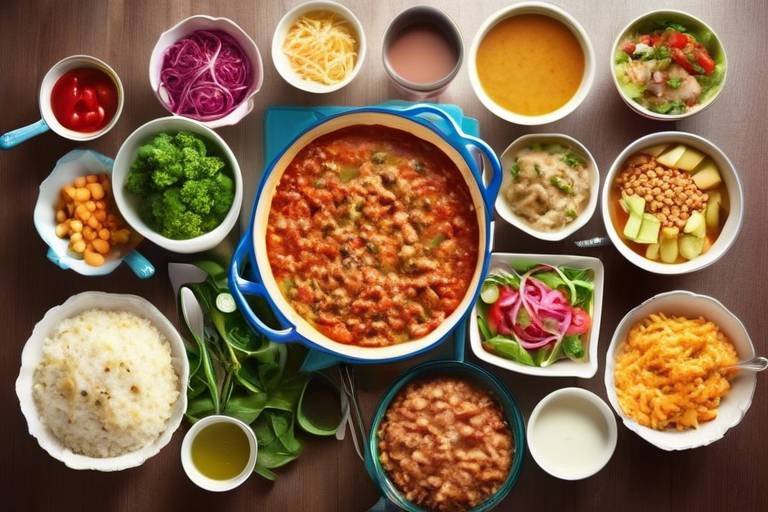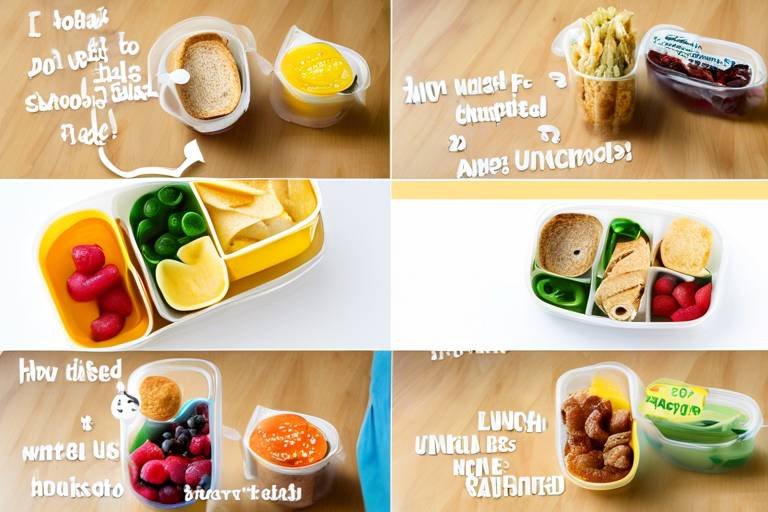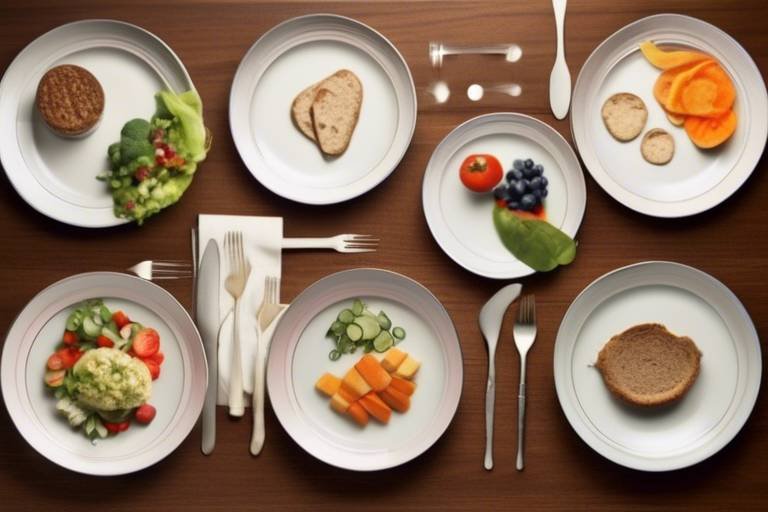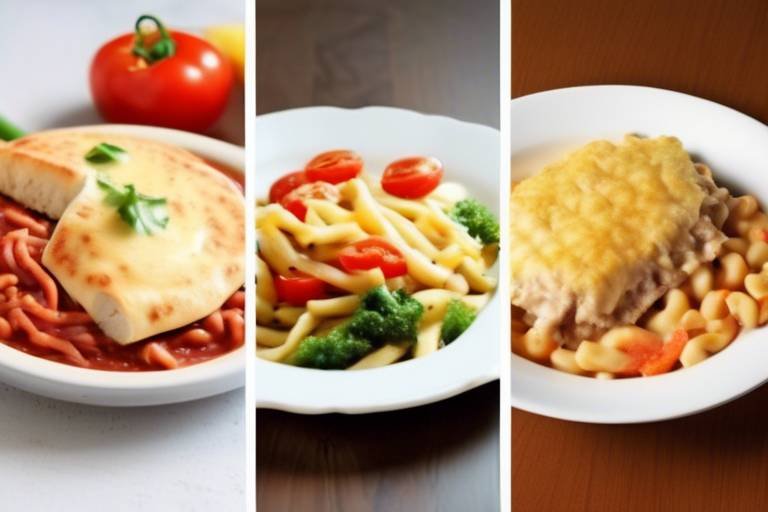Feeding a Family on a Tight Budget: 10 Healthy and Affordable Meals
In today's fast-paced world, feeding a family on a tight budget can feel like an uphill battle. However, it doesn't have to be! With a bit of creativity and planning, you can whip up nutritious meals that won't send your wallet into a tailspin. This article explores ten healthy and affordable meal ideas that are not only easy to prepare but also delicious enough to satisfy even the pickiest eaters in your household. Imagine sitting down to dinner, knowing you've provided your family with wholesome food without overspending. Sounds like a dream, right? Well, it's entirely possible!
First things first, let’s talk about the importance of meal planning. When you take the time to plan your meals for the week, you can strategically choose ingredients that work well together, reducing waste and ensuring that you use everything you buy. Think of meal planning as your roadmap to a week of healthy eating. It can help you avoid those last-minute takeout calls that can quickly add up. By mapping out your meals, you’ll not only save money but also time, making your week run smoother.
Now, onto the fun part: the meals! Each of the ten meal ideas we’ll explore is packed with flavor and nutrition. From hearty soups to vibrant salads, these meals are designed to keep your family full and happy without putting a dent in your budget. And don’t worry; we’ll also share some tips on budget-friendly ingredients that you can keep on hand to make these meals even easier to prepare. You might be surprised to learn that some of the most affordable ingredients can be incredibly versatile!
In the following sections, we will dive deeper into seasonal produce, affordable protein options, and healthy cooking techniques. By focusing on what's in season and available locally, you can enhance the flavor of your meals while also supporting local farmers. Plus, we’ll discuss how to make the most of leftovers, turning yesterday’s dinner into today’s lunch with a little imagination.
So, are you ready to transform your family meals? Let’s get cooking and discover how you can feed your family healthy, delicious meals without breaking the bank!
Effective meal planning can significantly reduce grocery costs. By knowing exactly what you need to buy and what you plan to cook, you can avoid impulse purchases and ensure that your meals are balanced and nutritious. Start by creating a weekly meal plan that outlines breakfast, lunch, and dinner for each day. This can be as simple as jotting down your ideas on a piece of paper or using a digital app designed for meal planning. The key is to stick to your list when you go grocery shopping. This way, you won’t be tempted by those flashy sales or items that aren’t part of your plan.
Identifying affordable ingredients is crucial for cooking on a budget. Here are some versatile staples to consider:
- Whole grains: Brown rice, quinoa, and oats are not only filling but also nutritious.
- Canned beans: A great source of protein and fiber, perfect for salads and stews.
- Frozen vegetables: Often cheaper than fresh and just as nutritious, they can be added to any meal.
- Seasonal produce: Using fruits and vegetables that are in season can save you money and enhance flavor.
Using seasonal fruits and vegetables not only saves money but also enhances flavor. When you buy produce that’s in season, you’re likely to get it at a lower price and with better taste. For example, summer brings an abundance of tomatoes and zucchini, while fall offers a bounty of squash and apples. Learning to identify what’s in season in your area can be a game-changer for your grocery budget. Incorporate these items into your meals for a burst of freshness that will delight your family’s taste buds!
Shopping at local farmers' markets can yield fresh, affordable produce. Not only do you get to support local farmers, but you can also find great deals on fruits and vegetables. Here are a few tips for making the most out of your local market visits:
- Go early for the best selection.
- Bring cash, as some vendors may not accept cards.
- Ask vendors for deals on bulk purchases or items that are nearing the end of their shelf life.
Understanding the benefits of frozen produce versus fresh can help you save money. Frozen fruits and vegetables are often picked at their peak ripeness and flash-frozen to preserve nutrients. This means they can be just as nutritious as fresh produce, sometimes even more so, especially if the fresh items have been sitting on store shelves for days. Plus, frozen options last longer, reducing food waste and allowing you to stock up when prices are low.
Affordable protein sources are essential for balanced meals. Incorporating beans, lentils, and eggs into your diet can provide essential nutrients without high costs. These ingredients are not only budget-friendly but also incredibly versatile. For instance, beans can be added to salads, soups, or even made into delicious veggie burgers. Lentils cook quickly and can be used in a variety of dishes, from stews to salads. Eggs are a fantastic source of protein and can be prepared in numerous ways, making them perfect for breakfast, lunch, or dinner.
Adopting healthy cooking methods can enhance meal quality while keeping costs down. Techniques such as steaming, grilling, and baking help preserve nutrients and flavor. For example, steaming vegetables retains their vitamins and minerals better than boiling. Grilling can add a delicious char to meats and veggies without the need for excessive oils or sauces. Baking is another fantastic method for preparing meals, allowing you to create healthy casseroles or roasted dishes with minimal effort.
Batch cooking allows families to prepare meals in advance, saving time and money. By dedicating a few hours on the weekend to cook large portions of meals, you can easily store them in the fridge or freezer for quick weeknight dinners. This not only reduces the temptation to order takeout but also ensures you have healthy options readily available. Think of batch cooking as your secret weapon against the busy weeknight rush!
Making the most of leftovers is a smart way to reduce food waste. Instead of letting yesterday's dinner go uneaten, get creative! Leftover roasted chicken can be transformed into a hearty soup, while extra vegetables can be tossed into a stir-fry or omelet. By repurposing leftovers, you not only save money but also minimize food waste, making your meals even more sustainable.
This section provides easy-to-follow recipes for ten healthy meals that are both budget-friendly and quick to prepare, ensuring families can eat well without overspending. Each recipe will highlight the key ingredients and cooking methods, making it simple for anyone to follow along.
Vegetarian meals can be cost-effective while being nutritious. Dishes like vegetable stir-fry, lentil soup, and chickpea salads are not only filling but also easy to prepare. They offer a variety of flavors and textures that will keep your family satisfied without breaking the bank.
One-pot meals simplify cooking and cleanup while being economical. Recipes like one-pot pasta, quinoa stir-fry, and vegetable curry allow you to combine ingredients for a nutritious family meal without the hassle of multiple pots and pans. Plus, they often taste even better the next day, making them perfect for leftovers!
Q: How can I save money on groceries?
A: Meal planning, shopping for seasonal produce, and using coupons can help reduce grocery costs significantly.
Q: Are frozen vegetables as healthy as fresh?
A: Yes, frozen vegetables are often frozen at peak ripeness, preserving their nutrients and can be just as healthy as fresh options.
Q: What are some budget-friendly protein sources?
A: Beans, lentils, eggs, and canned tuna are excellent, cost-effective sources of protein.
Q: How can I repurpose leftovers?
A: Get creative! Use leftover meats in salads or sandwiches, and add extra veggies to soups or stir-fries.

Meal Planning Strategies
When it comes to feeding a family on a tight budget, effective meal planning is your secret weapon. Imagine walking into a grocery store with a clear plan in mind rather than wandering aimlessly down the aisles, overwhelmed by choices. Meal planning not only helps you save money, but it also ensures that you're putting nutritious food on the table. The first step is to dedicate some time each week to sit down and map out your meals. This might sound tedious, but think of it as creating a roadmap for your culinary journey ahead!
Start by checking what you already have in your pantry and fridge. This way, you can incorporate those ingredients into your meal plan, reducing waste and saving cash. Next, consider your family’s preferences and dietary needs. Are there any meals that everyone loves? Perhaps a hearty chili or a comforting pasta dish? Make a list of these favorites and aim to include them in your weekly rotation. A well-balanced meal plan typically includes:
- Fruits and vegetables
- Whole grains
- Lean proteins
- Dairy or dairy alternatives
Once you’ve decided on the meals for the week, create a shopping list based on your plan. This list will be your guide, helping you avoid impulse buys and stick to your budget. It’s like having a trusty sidekick that keeps you focused! When you go grocery shopping, try to stick to the perimeter of the store where fresh foods are usually located, avoiding the processed items in the middle aisles.
Another effective strategy is to prepare meals in bulk. For instance, if you’re making a casserole, why not double the recipe? You can freeze the extra portion for a busy night when cooking from scratch feels impossible. Batch cooking not only saves time but also ensures you have healthy options readily available, making it less likely that you’ll resort to takeout or unhealthy snacks.
Lastly, don’t forget to be flexible. Life can be unpredictable, and sometimes plans change. If you find yourself with unexpected leftovers, incorporate them into your meal plan for the next few days. This not only minimizes food waste but also adds variety to your meals. Think of your meal plan as a living document that can adapt to your family’s needs and preferences.
By following these meal planning strategies, you can create a balanced and nutritious diet for your family without breaking the bank. Remember, it’s all about being organized and making smart choices. You’ve got this!

Budget-Friendly Ingredients
When it comes to feeding a family on a budget, the choice of ingredients can make all the difference. By selecting affordable and nutritious staples, you can create meals that not only satisfy hunger but also promote health. The key is to focus on versatility, allowing you to use the same ingredients in multiple dishes throughout the week. For instance, items like rice, beans, and oats can serve as the foundation for a variety of meals, making them essential components of any budget-conscious kitchen.
One of the best strategies is to stock up on seasonal produce. Not only is it often cheaper, but it also tastes better since it’s harvested at its peak. For example, in the summer, you might find an abundance of tomatoes, zucchini, and corn, while fall brings squash and apples. Incorporating these ingredients into your meal plan can elevate your dishes and keep your grocery bill in check. Here’s a quick table to illustrate the seasonal produce you might consider:
| Season | Fruits | Vegetables |
|---|---|---|
| Spring | Strawberries, Rhubarb | Asparagus, Spinach |
| Summer | Peaches, Berries | Tomatoes, Zucchini |
| Fall | Apples, Pears | Squash, Carrots |
| Winter | Citrus Fruits | Kale, Root Vegetables |
In addition to seasonal produce, don’t overlook the power of local markets. Shopping at farmers' markets can often yield fresh fruits and vegetables at a fraction of the cost of grocery stores. Not only do you get better prices, but you also support local farmers, which is a win-win for your community. When you visit these markets, consider going towards the end of the day when vendors are more likely to discount their goods to avoid taking them back home.
Another important consideration is the choice between frozen and fresh produce. While fresh fruits and vegetables are often preferred, frozen options can be just as nutritious and sometimes more affordable. Freezing preserves the nutrients, and you can buy them in bulk, which helps cut down on costs. So, if you find yourself in a pinch, don’t hesitate to reach for those frozen peas or mixed vegetables—they can be a lifesaver in a quick stir-fry or soup.
Lastly, let’s talk about protein. Affordable protein sources like beans, lentils, and eggs are not only budget-friendly but also packed with essential nutrients. These ingredients can be used in various dishes—from hearty stews to simple salads—ensuring that your family gets the protein they need without straining your wallet. By incorporating these budget-friendly ingredients into your meal planning, you can create a diverse menu that keeps your family satisfied and healthy.
- What are some examples of budget-friendly meals? Meals like bean chili, vegetable stir-fry, and egg fried rice are great options.
- How can I make my meals more nutritious on a budget? Focus on incorporating whole grains, seasonal produce, and affordable protein sources.
- Is it better to buy fresh or frozen vegetables? Both have their benefits; frozen veggies are often cheaper and last longer, while fresh can offer better flavor.

Seasonal Produce
When it comes to feeding your family on a budget, one of the smartest strategies is to incorporate into your meals. Not only does it save you money, but it also enhances the flavor and nutritional value of your dishes. Think about it: when you choose fruits and vegetables that are in season, you're not just getting the freshest options available; you're also supporting local farmers and reducing your carbon footprint. It's like hitting three birds with one stone!
But how do you know what's in season? A quick glance at a seasonal produce chart can be a game changer. For instance, in the spring, you might find asparagus, strawberries, and peas, while summer brings a bounty of tomatoes, zucchini, and peaches. Autumn is perfect for squash, apples, and Brussels sprouts, and winter offers hearty options like root vegetables and citrus fruits. By planning your meals around these seasonal gems, you can create delicious and nutritious dishes that won’t break the bank.
| Season | Fruits | Vegetables |
|---|---|---|
| Spring | Strawberries, Cherries | Asparagus, Spinach |
| Summer | Peaches, Watermelon | Tomatoes, Zucchini |
| Autumn | Apples, Pears | Squash, Brussels Sprouts |
| Winter | Citrus Fruits, Pomegranates | Root Vegetables, Kale |
Incorporating seasonal produce into your meals can also inspire creativity in the kitchen. Have you ever tried making a zucchini and corn fritter in the summer or a comforting pumpkin soup in the fall? These dishes not only highlight the flavors of the season but also make use of ingredients that are often more affordable when they're in their peak season. Plus, cooking with what's in season can lead to a more varied diet, which is essential for maintaining a healthy lifestyle.
So, the next time you head to the grocery store or farmers' market, take a moment to consider what's in season. Your wallet, your taste buds, and your family’s health will thank you for it. Remember, eating with the seasons is not just a trend; it’s a sustainable approach to enjoying food that can lead to a happier, healthier family.
- What are the benefits of eating seasonal produce? Eating seasonal produce is not only cost-effective but also ensures that you're consuming fruits and vegetables at their peak freshness, which enhances flavor and nutrition.
- How can I find out what's in season in my area? You can check local farmers' markets, agricultural extension services, or online seasonal produce charts specific to your region.
- Does seasonal produce taste better? Yes! Seasonal produce is typically harvested at its peak ripeness, which means it often tastes better than out-of-season options that may have been picked early and stored for long periods.

Local Markets
Shopping at local farmers' markets can be a game-changer for families looking to eat healthily without draining their wallets. These markets are often bursting with fresh, seasonal produce that not only tastes better but is also more nutritious. Imagine biting into a juicy tomato that was picked just hours before; the flavor is unparalleled compared to what you might find in a grocery store. Plus, buying directly from farmers means you're supporting your community and reducing the carbon footprint associated with transporting food over long distances.
When you visit a local market, you can often find a variety of goods beyond just fruits and vegetables. Many vendors sell homemade jams, fresh-baked bread, and even locally sourced meats and dairy products. This variety allows you to create a diverse meal plan that keeps your family excited about mealtime. But how do you make the most of your local market experience? Here are a few tips:
- Go Early: Arriving early gives you the best selection of fresh produce.
- Bring Cash: Some vendors may not accept cards, so it's wise to have cash on hand.
- Ask Questions: Don’t hesitate to ask farmers about their growing practices or recipe suggestions.
- Buy in Bulk: If you find a great deal, consider buying in bulk and sharing with friends or neighbors.
Moreover, local markets often have a community vibe that grocery stores lack. You can chat with the farmers, learn about their practices, and even discover new recipes or cooking tips. This interaction not only enriches your shopping experience but also fosters a sense of community and connection. By purchasing from local vendors, you're not just buying food; you're investing in your local economy and helping to sustain small businesses.
In addition to all these benefits, shopping at local markets can lead to significant savings. Since these farmers often sell directly to consumers, you can find prices that are often lower than those at supermarkets. Plus, buying seasonal produce means you can take advantage of lower prices when certain fruits and vegetables are in abundance. So, next time you're planning your grocery shopping, consider checking out your local farmers' market. You might be surprised at the quality and savings you can find!

Frozen vs. Fresh
When it comes to choosing between frozen and fresh produce, many families find themselves in a bit of a dilemma. On one hand, fresh fruits and vegetables are often touted as the healthiest option, bursting with flavor and nutrients. On the other hand, frozen produce can be a budget-friendly alternative that offers convenience and long shelf life. So, what's the best choice for your family? Let's dive into the pros and cons of both options to help you make an informed decision.
Fresh produce is undeniably appealing. There's something about biting into a crisp apple or enjoying a ripe tomato that just feels right. However, fresh fruits and vegetables can sometimes be a bit pricey, especially if you're buying out of season. Plus, they have a shorter shelf life, which means they can spoil quickly if not consumed in time. On the flip side, frozen produce is typically harvested at its peak ripeness and then flash-frozen, locking in nutrients and flavor. This means that frozen fruits and vegetables can be just as nutritious as their fresh counterparts, and often cheaper!
To better understand the differences, let's take a look at a quick comparison:
| Aspect | Fresh Produce | Frozen Produce |
|---|---|---|
| Nutritional Value | High, but can diminish over time | High, often comparable to fresh |
| Cost | Varies, can be expensive | Generally more affordable |
| Shelf Life | Short, can spoil quickly | Long, can last for months |
| Convenience | Requires washing and preparation | Ready to use, no prep needed |
As you can see from the table, both fresh and frozen produce have their advantages and disadvantages. If you're planning meals for the week, consider incorporating a mix of both. For instance, fresh greens can be used in salads, while frozen vegetables can easily be tossed into stir-fries or soups. This way, you can enjoy the best of both worlds while keeping your grocery bill in check.
Another important factor to consider is how you plan to use the produce. If you're making a dish that requires a lot of chopping or cooking, frozen vegetables can save you time and effort. They’re also perfect for smoothies, where you might prefer the icy texture that frozen fruits provide. On the other hand, if you enjoy snacking on raw fruits and veggies, fresh produce is the way to go.
Ultimately, the choice between frozen and fresh comes down to your family's preferences, dietary needs, and budget. By understanding the benefits of both options, you can make informed decisions that keep your meals healthy, delicious, and affordable.
- Is frozen produce less nutritious than fresh? Not necessarily. Frozen produce can be just as nutritious as fresh since it's often frozen at peak ripeness.
- How long can frozen fruits and vegetables be stored? Frozen produce can last for several months, making it a convenient option for meal planning.
- Are there any downsides to frozen produce? Some frozen products may contain added sugars or preservatives, so it's essential to check the labels.

Protein Options
When it comes to feeding your family on a budget, can make a world of difference. Protein is an essential part of our diet, providing the building blocks for muscles, skin, and hormones. However, many people think that getting enough protein means spending a fortune on meat. The truth is, there are plenty of affordable protein sources that can keep your meals nutritious without emptying your wallet.
One of the most versatile and budget-friendly protein options is beans. Whether you choose black beans, chickpeas, or kidney beans, these little powerhouses are packed with protein and fiber, making them a great addition to salads, soups, and stews. Not only are they inexpensive, but they also have a long shelf life, which means you can stock up and use them whenever you need a quick meal. In fact, a can of beans can cost as little as $0.80, and it can easily serve a family of four!
Lentils are another fantastic option. These legumes cook quickly and are incredibly nutritious. Rich in protein and iron, lentils can be used in a variety of dishes, from hearty soups to delicious veggie burgers. Plus, they are often cheaper than meat, making them a smart choice for families. You can buy dried lentils in bulk for around $1.50 per pound, which yields a significant amount when cooked.
Don't overlook the humble egg. Eggs are not only a great source of protein but are also incredibly versatile. You can scramble them, boil them, or use them in baking. A dozen eggs typically costs less than $3, and with each egg containing about 6 grams of protein, they are an excellent way to stretch your budget while keeping your meals satisfying. Think of them as nature's little protein packages!
For those who enjoy meat, consider chicken thighs or ground turkey as economical protein sources. Chicken thighs are often cheaper than chicken breasts, and they tend to be more flavorful and juicy. Ground turkey can be used in a variety of dishes, from tacos to meatloaf, and it usually comes at a lower price point than beef. A simple comparison of prices might look like this:
| Protein Source | Average Cost per Pound | Protein per Serving |
|---|---|---|
| Beans (canned) | $0.80 | 7g |
| Lentils (dried) | $1.50 | 18g |
| Eggs | $3.00 (dozen) | 6g |
| Chicken Thighs | $2.00 | 26g |
| Ground Turkey | $3.00 | 22g |
As you can see, there are numerous budget-friendly protein options available. By incorporating a mix of these ingredients into your meals, you can create delicious and healthy dishes that won't break the bank. So, the next time you're planning your grocery list, remember that protein doesn't have to come from expensive cuts of meat. Instead, think creatively and explore the wonderful world of legumes, eggs, and affordable meats!
- What are the cheapest protein sources? Beans, lentils, eggs, and chicken thighs are some of the most affordable options.
- How can I incorporate more plant-based proteins into my diet? Try adding beans and lentils to soups, salads, and stir-fries for a nutritious boost.
- Are frozen proteins as nutritious as fresh? Yes, frozen proteins can be just as nutritious as fresh, and they often last longer, reducing waste.
- Can I meal prep with these protein sources? Absolutely! Many of these proteins can be cooked in bulk and stored for easy meals throughout the week.

Healthy Cooking Techniques
When it comes to feeding your family on a budget, play a pivotal role in not only saving money but also enhancing the nutritional value of your meals. Think about it: cooking doesn't have to be a chore or a drain on your wallet! By adopting certain methods, you can whip up delicious, nutritious meals that your family will love without spending a fortune. So, what are these techniques, and how can they help you? Let’s dive in!
One of the most effective methods is steaming. This technique preserves the nutrients in vegetables better than boiling, where the vitamins can leach into the water. Imagine biting into a vibrant, perfectly steamed broccoli floret that still retains its crunch and bright green color—it's not just good for you; it tastes fantastic! Plus, steaming is incredibly simple: just a pot of water and a steamer basket, and you’re golden. Pair steamed veggies with a protein source, and you’ve got a balanced meal without the fuss.
Next up is grilling. Not only does grilling add a wonderful smoky flavor to your food, but it also requires little to no added fat. This means you can enjoy your favorite meats and veggies in a healthier way. Think about marinating chicken breasts or zucchini slices and throwing them on the grill. Not only will you enjoy a delicious meal, but you’ll also be using less oil, which is a win for your wallet and your waistline!
Then we have baking, a versatile technique that allows you to prepare everything from casseroles to roasted vegetables. Baking is particularly great for batch cooking; you can prepare multiple servings at once, which is perfect for busy families. Imagine filling your oven with a healthy lasagna packed with veggies or a tray of roasted sweet potatoes and carrots. You’ll have meals ready for several days, cutting down on cooking time and costs!
Another fantastic technique is batch cooking. This involves preparing large quantities of food at once, which can then be portioned out for meals throughout the week. It’s like meal prepping on steroids! Not only does this save you time during the week, but it also helps you avoid the temptation of expensive takeout. You can make a big pot of chili or soup, divide it into containers, and voilà—you have healthy lunches or dinners ready to go!
Lastly, let’s talk about leftover utilization. This technique is all about making the most of what you already have. Instead of letting leftovers languish in the fridge, get creative! For example, if you have leftover roasted chicken, you can shred it and toss it into a salad, or mix it with some veggies and rice for a quick stir-fry. Not only does this reduce food waste, but it also keeps your meals interesting and varied.
Incorporating these healthy cooking techniques into your routine can significantly impact your family's diet and your grocery budget. It’s all about being resourceful and creative in the kitchen. So, the next time you’re planning your meals, consider how you can use these methods to create delicious, nutritious, and budget-friendly meals that your family will rave about!
- What is the best cooking method for preserving nutrients? Steaming is generally considered the best method for preserving the nutrients in vegetables.
- How can I make batch cooking easier? Plan your meals ahead of time and choose recipes that can be easily scaled up.
- What are some easy leftover recipes? You can make stir-fries, casseroles, or soups using leftover ingredients.

Batch Cooking
Batch cooking is a game-changer for families looking to save both time and money while ensuring they eat healthy meals throughout the week. Imagine coming home after a long day and having a delicious, nutritious meal ready to go. Sounds like a dream, right? Well, with batch cooking, that dream can become a reality! By dedicating just a few hours on the weekend or any day that works for you, you can prepare multiple meals in advance, allowing you to enjoy home-cooked goodness without the daily hassle of cooking.
So, how does batch cooking work? The idea is simple: you cook larger quantities of food in one go and then store them in portions for later. This method not only saves time but also reduces food waste and helps you stick to your budget. When you buy ingredients in bulk, you often get a better price, and you can use them across several meals. For example, if you roast a whole chicken, you can use the leftovers in salads, sandwiches, or soups throughout the week. It’s like having a culinary Swiss Army knife at your disposal!
To get started with batch cooking, here are some practical steps to follow:
- Plan Your Meals: Before hitting the grocery store, create a meal plan for the week. Choose recipes that share similar ingredients to maximize your purchases.
- Shop Smart: Buy in bulk and stock up on staples like rice, beans, and frozen vegetables. These items are not only affordable but also versatile.
- Cook in Batches: Allocate a few hours to cook. You can prepare multiple recipes at once, such as soups, stews, or casseroles, which can easily be portioned out and stored.
- Store Properly: Use clear containers to store your meals in the fridge or freezer. Label them with dates to keep track of freshness.
One of the best aspects of batch cooking is the flexibility it offers. You can easily adjust recipes based on your family’s preferences or dietary restrictions. For instance, if someone in your family is vegetarian, you can prepare a big batch of vegetable chili while also cooking some chicken for the meat-eaters. This way, everyone gets a meal they enjoy without doubling your cooking time.
Not only does batch cooking help you save time and money, but it can also promote healthier eating habits. When you have nutritious meals ready to go, you're less likely to reach for unhealthy snacks or fast food. Plus, cooking in bulk can encourage you to try new recipes and flavors, making mealtime exciting rather than a chore.
In conclusion, batch cooking is a fantastic strategy for families aiming to eat well on a budget. It’s about making the most of your time and resources while ensuring that you and your loved ones enjoy delicious, wholesome meals. So why not give it a try this week? You might just find that it transforms your approach to cooking and dining!

Leftover Utilization
Making the most of leftovers is not just a smart way to reduce food waste; it’s also a fantastic opportunity to unleash your culinary creativity! Think about it: those extra portions of last night’s dinner can be transformed into a brand-new meal, saving you time and money. Instead of tossing them in the fridge and forgetting about them, why not give them a second life? You’ll be amazed at how a little imagination can turn simple leftovers into something spectacular.
For instance, let’s say you had a delicious roasted chicken for dinner. The next day, instead of just reheating it, consider shredding the leftover chicken and tossing it into a vibrant salad or mixing it into a flavorful soup. Or, if you have leftover rice, it can easily become the base for a hearty stir-fry with whatever veggies you have on hand. This not only minimizes waste but also allows you to enjoy a variety of meals throughout the week without the extra effort of cooking from scratch each time.
Here are some creative ideas to inspire your leftover utilization:
- Wrap it Up: Use leftover meats or veggies to create delicious wraps. Just add some fresh greens, a tasty sauce, and you’re good to go!
- Soup it Up: Almost any leftover can find its way into a hearty soup. Just throw it into a pot with some broth and seasonings, and you have a warm, comforting meal.
- Frittata Magic: Leftover vegetables can be mixed with eggs to create a quick and nutritious frittata, perfect for breakfast or a light dinner.
- Grain Bowls: Combine leftover grains with fresh veggies, proteins, and a drizzle of dressing for a satisfying grain bowl.
To help you get started, consider this simple table that outlines how to repurpose common leftovers:
| Leftover | Repurposing Idea |
|---|---|
| Roast Chicken | Shred for salads, tacos, or soups |
| Cooked Vegetables | Add to omelets or stir-fries |
| Rice or Quinoa | Use in grain bowls or fried rice |
| Pasta | Mix with sauce for a quick bake or salad |
By creatively utilizing your leftovers, you not only save money but also contribute to a more sustainable lifestyle. Remember, every meal is an opportunity to innovate and save! So, the next time you find yourself with extra food, don’t just put it away—think about how you can turn it into something new and exciting. Your taste buds (and your wallet) will thank you!
Q: How can I store leftovers properly?
A: Make sure to store leftovers in airtight containers and refrigerate them within two hours of cooking. Label them with the date to keep track of freshness.
Q: How long can I keep leftovers in the fridge?
A: Generally, leftovers can be safely consumed within 3 to 4 days. If you can't eat them in that time frame, consider freezing them for later use.
Q: Can I reheat leftovers multiple times?
A: It's best to reheat leftovers only once. Each time you reheat, the quality may diminish, and there's a risk of bacterial growth.
Q: What are some safe ways to reheat leftovers?
A: You can reheat leftovers in the microwave, on the stovetop, or in the oven. Just ensure they reach an internal temperature of 165°F (74°C) to be safe.

Simple Recipes
When it comes to feeding a family on a tight budget, simplicity is key. You want meals that are not only affordable but also nutritious and delicious. Here are ten simple recipes that check all the boxes, making it easy to keep your family satisfied without straining your wallet. Each recipe is designed to be quick to prepare, ensuring that you can whip up a healthy meal even on the busiest days.
Let’s dive into some crowd-pleasers that will have everyone asking for seconds:
| Recipe | Ingredients | Preparation Time |
|---|---|---|
| Vegetable Stir-Fry | Mixed seasonal vegetables, soy sauce, rice | 15 minutes |
| Chickpea Salad | Chickpeas, cucumber, tomatoes, olive oil, lemon | 10 minutes |
| Egg Fried Rice | Leftover rice, eggs, peas, carrots, soy sauce | 20 minutes |
| Lentil Soup | Lentils, carrots, celery, onion, broth | 30 minutes |
| One-Pot Pasta | Pasta, canned tomatoes, garlic, spinach | 25 minutes |
These recipes are not just simple; they also use budget-friendly ingredients that you can easily find at your local grocery store or farmer's market. For instance, a vegetable stir-fry can be made with whatever seasonal vegetables are available, making it a versatile option. The beauty of these meals is that they can be customized based on what you have on hand, allowing for creativity without the added expense.
Another fantastic option is the chickpea salad. This recipe is a powerhouse of nutrition, packed with protein and fiber, and it takes less than 10 minutes to prepare. Just toss together some canned chickpeas, fresh vegetables, a drizzle of olive oil, and a squeeze of lemon for a refreshing dish that’s perfect for lunch or dinner.
Don’t forget about leftovers! The egg fried rice is an excellent way to use up any leftover rice from the previous night’s dinner. By adding eggs, peas, and carrots, you can create a hearty meal that feels entirely new. Plus, it’s a hit with kids and adults alike!
For those chilly evenings, a warm bowl of lentil soup can be incredibly comforting. Lentils are not only inexpensive but also rich in protein and iron. Simply sauté some onions, carrots, and celery, add lentils and broth, and let it simmer. In less than 30 minutes, you’ll have a wholesome soup that can feed the whole family.
Finally, let’s talk about one-pot pasta. This dish is a lifesaver for busy families. Just throw your pasta, canned tomatoes, garlic, and spinach into one pot, and let it cook together. The result? A deliciously creamy pasta dish that requires minimal cleanup!
In summary, these simple recipes are all about making healthy eating accessible and enjoyable. By choosing the right ingredients and utilizing a few quick cooking techniques, you can create meals that are not only budget-friendly but also satisfying and nutritious. So, next time you're at the grocery store, remember that eating well doesn't have to cost a fortune!
Q: How can I make these meals even more affordable?
A: Look for sales, use coupons, and buy in bulk when possible. Also, consider shopping at discount grocery stores or local markets for fresh produce at lower prices.
Q: Can I substitute ingredients in these recipes?
A: Absolutely! Feel free to swap out ingredients based on what you have at home or what’s on sale. Cooking should be flexible and fun!
Q: How do I store leftovers properly?
A: Store leftovers in airtight containers in the fridge. Most meals can be safely stored for 3-4 days. You can also freeze portions for later use.

Vegetarian Options
When it comes to feeding a family on a budget, vegetarian meals are a fantastic option that can be both nutritious and wallet-friendly. Not only do they often cost less than meat-based dishes, but they also provide a wealth of vitamins, minerals, and fiber. Think about it: beans, lentils, and grains are not just affordable, they’re also packed with protein and essential nutrients. By incorporating these ingredients into your weekly meal plan, you can create satisfying dishes that your entire family will love.
One of the best things about vegetarian cooking is its versatility. You can whip up a hearty vegetable stir-fry with whatever seasonal produce is on sale, or you can create a comforting chickpea curry that warms the soul. The possibilities are endless! Plus, meals like vegetable soups or pasta primavera allow you to use up any leftover veggies in your fridge, reducing waste and saving money.
Here are a few vegetarian meal ideas that are both easy to make and budget-friendly:
- Lentil Tacos: Use lentils as a filling instead of meat. Season them with taco spices, and serve with your favorite toppings.
- Vegetable Stir-Fry: Toss together seasonal vegetables with soy sauce and serve over rice or noodles for a quick meal.
- Chickpea Salad: Mix canned chickpeas with diced vegetables, olive oil, and lemon juice for a refreshing and filling salad.
- Vegetable Soup: A great way to use up leftover vegetables, just simmer everything together with broth and herbs.
In addition to being cost-effective, vegetarian meals can be a fun way to explore different cuisines. You might find yourself trying out Indian dal, Italian risotto, or Mexican enchiladas made with beans instead of meat. Each dish not only brings unique flavors but also introduces your family to a variety of cultures, making mealtime an adventure!
Moreover, you can make these meals even more cost-effective by purchasing ingredients in bulk. Items like rice, beans, and lentils are often cheaper when bought in larger quantities. Not to mention, they have a long shelf life, so you won’t have to worry about them going bad quickly. This way, you can always have the essentials on hand for those busy nights when cooking from scratch seems daunting.
In conclusion, embracing vegetarian options doesn't mean sacrificing flavor or nutrition. With a bit of creativity and planning, you can create delicious meals that fit your budget and keep your family healthy. So why not give it a try? You might just find that some of your new favorite meals are meat-free!
1. Are vegetarian meals really cheaper than meat-based meals?
Yes! Vegetarian ingredients like beans, lentils, and grains are typically less expensive than meat. Plus, they can stretch further, providing more servings per meal.
2. How can I ensure my vegetarian meals are nutritious?
Focus on incorporating a variety of vegetables, whole grains, and protein sources like beans and nuts to ensure you’re getting a balanced diet.
3. Can I still get enough protein from vegetarian meals?
Absolutely! Foods like beans, lentils, tofu, and quinoa are great sources of protein. Combining different protein sources can help you meet your needs.
4. What are some easy vegetarian meals for beginners?
Start with simple dishes like vegetable stir-fries, pasta with marinara sauce, or bean tacos. These meals are quick, easy, and delicious!

One-Pot Meals
When it comes to feeding a family on a budget, are a game changer. Imagine this: you come home after a long day, and the last thing you want to do is spend hours in the kitchen. One-pot meals not only simplify cooking but also make cleanup a breeze. These meals are perfect for busy families, allowing you to combine various ingredients into a single pot, maximizing flavor and nutrition while minimizing effort and expense.
One-pot meals can be incredibly versatile. You can throw in whatever you have on hand, making them a fantastic way to use up leftovers or ingredients that are about to go bad. For instance, consider a hearty vegetable and bean stew. Just toss in some chopped onions, garlic, carrots, and any seasonal vegetables you have, add a can of beans, some broth, and spices, and let it simmer. In less than an hour, you have a nutritious meal that satisfies everyone at the table.
Another excellent one-pot option is the classic chicken and rice. This dish is not only filling but also allows you to stretch your protein dollar. Start by browning some chicken thighs in the pot, then add rice, broth, and your choice of vegetables. The beauty of one-pot meals is that they often get better as they sit, allowing the flavors to meld together beautifully. Plus, you can easily adjust the recipe based on what you have available, making it a flexible choice for any night of the week.
For those who enjoy a little spice, one-pot chili is another fantastic option. You can whip up a big batch using ground turkey or beef, beans, tomatoes, and a mix of spices. Not only is it hearty, but it also freezes well, allowing you to save portions for later. This means you can have a delicious homemade meal ready to go, without any additional prep work.
Here’s a quick look at some popular one-pot meals that are both healthy and budget-friendly:
| Meal | Main Ingredients | Cooking Time |
|---|---|---|
| Vegetable and Bean Stew | Onions, garlic, carrots, seasonal veggies, beans | 45 minutes |
| Chicken and Rice | Chicken thighs, rice, broth, mixed vegetables | 50 minutes |
| One-Pot Chili | Ground turkey, beans, tomatoes, spices | 1 hour |
Utilizing one-pot meals not only saves time and money but also encourages creativity in the kitchen. You can experiment with different flavor combinations and ingredients, making each meal unique. Plus, these meals are often packed with nutrients, ensuring that your family is getting wholesome food without the hefty price tag.
So next time you’re planning your weekly meals, consider incorporating a few one-pot recipes into your rotation. They’re not just a lifesaver for busy nights; they’re a delicious way to keep your family healthy and happy without straining your budget. And remember, cooking doesn’t have to be complicated to be tasty!
- What are the benefits of one-pot meals? One-pot meals save time, reduce cleanup, and allow for creative cooking using various ingredients.
- Can one-pot meals be healthy? Absolutely! With the right ingredients, one-pot meals can be nutritious and balanced.
- How can I make one-pot meals more interesting? Experiment with different spices, proteins, and seasonal vegetables to keep things fresh and exciting.
Frequently Asked Questions
- How can I feed my family healthy meals on a tight budget?
Feeding your family nutritious meals doesn't have to cost a fortune. Start by planning your meals for the week. This allows you to make a shopping list based on what you need, reducing impulse buys. Focus on budget-friendly ingredients like beans, lentils, and seasonal produce, which are not only affordable but also packed with nutrients.
- What are some affordable ingredients I should always have on hand?
Stocking your pantry with versatile staples can save you money in the long run. Consider keeping items like rice, pasta, canned tomatoes, frozen vegetables, and eggs. These ingredients can be used in a variety of meals, allowing you to create different dishes without breaking the bank.
- Is it cheaper to buy fresh produce or frozen?
It often depends on the season and what you're buying. Frozen produce can be more cost-effective, especially when certain fruits and vegetables are out of season. They are usually picked at peak ripeness and flash-frozen to preserve nutrients. Fresh produce can be more flavorful, but always check for sales or local markets to find the best deals.
- How can I make the most of leftovers?
Leftovers can be a lifesaver when it comes to saving money and reducing waste. Get creative! For example, use leftover roasted vegetables in a frittata or turn extra grains into a salad. Repurposing leftovers not only saves you time but also adds variety to your meals.
- What are some healthy cooking techniques to consider?
Healthy cooking techniques can enhance the nutrition of your meals. Opt for steaming, grilling, or baking instead of frying. These methods help retain the nutrients in your food while keeping it low in fat. Plus, they can add delicious flavors without the need for heavy sauces or extra calories.
- Can vegetarian meals be budget-friendly?
Absolutely! Vegetarian meals are often more affordable than meat-based dishes. Ingredients like beans, lentils, and grains are not only inexpensive but also provide essential proteins and nutrients. With a little creativity, you can whip up delicious vegetarian meals that are both satisfying and easy on the wallet.
- What are some easy one-pot meal ideas?
One-pot meals are fantastic for busy families! They simplify cooking and cleanup while being economical. Think of dishes like vegetable stir-fry with rice, chili, or a hearty stew. These meals can be made with whatever ingredients you have on hand, making them a great way to use up leftovers and reduce waste.



















